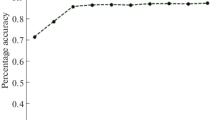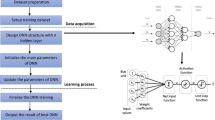Abstract
In Taiwan, more and more enterprises face the problems of financial distress in recent years. Besides, it is also noted that the volume of outstanding debt to corporations increases in Taiwan. An improvement in distress prediction accuracy can lead to save tens of billions of dollars. The firms which face financial distress will reveal many signs on financial data. Therefore, this study hopes to provide to managers and investors as a reference for decisions making through systematic approach as it can look for firms facing financial distress. In this paper, a novel prediction system is proposed which is based on intelligent classification to distinguish bankruptcy prediction. This method is referred to as a cerebellar model neural network (CMNN). A CMNN can be thought of as a learning mechanism imitating the cerebellum of a human being. Through training, this CMNN can be viewed like an expert of financial analyzer and then it can be applied to bankruptcy prediction. This study uses an artificial neural network, a genetic programming, and the proposed CMNN to construct financial distress prediction models and compare the performance of above three models using some Taiwanese company data, and it confirms CMNN is better than the others. By doing this, it can help understand and predict financial condition of firms and prevent the firms from insolvency. The CMNN yields the best prediction through the efficient infer reasoning of CMNN. Thus, the result is feasible to construct the financial distress prediction model.



Similar content being viewed by others
References
Beaver, W.H.: Financial ratios as predictors of failure. J. Account. Res. 4(1), 71–111 (1966)
Altman, E.I.: Financial ratios, discriminant analysis and the prediction of corporate bankruptcy. J. Finance 23(4), 578–609 (1968)
Deakin, E.B.: A discriminant analysis of predictors of business failure. J. Account. Res. 10(1), 167–179 (1972)
Demers, E., Joos, P.: IPO failure risk. J. Account. Res. 45(2), 333–371 (2007)
Lin, W.Y., Hu, Y.H., Tsai, C.F.: Machine learning in financial crisis prediction: a survey. IEEE Trans. Syst. Man Cybern. C 42(4), 421–436 (2012)
Odom, M.D., Sharda, R.: A neural network for bankruptcy prediction. IEEE INNS Int. Jt. Conf. Neural Netw. 2, 163–168 (1990)
Lensberg, T., Eilifsen, A., Mckee, T.E.: Bankruptcy theory development and classification via genetic programming. Eur. J. Oper. Res. 169, 677–697 (2006)
Ohlson, J.: Financial ratios and the probabilistic prediction of bankruptcy. J. Account. Res. 18(1), 109–131 (1980)
Gilles, Z., Pictet, O.V., Masutti, O.: Genetic programming with syntactic restrictions applied to financial volatility forecasting. In: Computational Methods in Decision-Making, Economics and Finance, pp. 557–581. Springer, US (2002)
Becker, Y.L., Fei, P., Lester, A.M.: Stock selection—an innovative application of genetic programming methodology. Genet Program Theory Pract IV 1, 315–334 (2007)
Espejo, P.G., Ventura, S., Herrera, F.: A survey on the application of genetic programming to classification. IEEE Trans. Syst. Man Cybern. C 40(2), 121–144 (2010)
Etemadi, H., Rostamy, A.A.A., Dehkordi, H.F.: A genetic programming model for bankruptcy prediction: evidence from Iran. Expert Syst. Appl. 36(2), 3199–3207 (2009)
Almeida, R.J., Vieira, S.M., da Costa Sousa, J.M., Kaymak, U.: The prediction of bankruptcy using weighted fuzzy classifiers. In: Proceedings of the III European Conference on Computational Mechanics, pp. 457–457 (2006)
Andrés, J.D., Lorca, P., Juez, F.J.D.C., Lasheras, F.S.: Bankruptcy forecasting: a hybrid approach using fuzzy c-means clustering and multivariate adaptive regression splines (MARS). Expert Syst. Appl. 38(3), 1866–1875 (2011)
Lin, C.M., Chen, L.Y., Yeung, D.S.: Adaptive filter design using recurrent cerebellar model articulation controller. IEEE Trans. Neural Netw. 21(7), 1149–1157 (2010)
Lin, C.M., Li, H.Y.: A novel adaptive wavelet fuzzy cerebellar model articulation control system design for voice coil motors. IEEE Trans. Ind. Electron. 59(4), 2024–2033 (2012)
Lin, C.M., Li, H.Y.: TSK fuzzy CMAC-based robust adaptive backstepping control for uncertain nonlinear systems. IEEE Trans. Fuzzy Syst. 20(6), 1147–1154 (2012)
Lin, C.M., Hou, Y.L., Chen, T.Y., Chen, K.H.: Breast nodules computer-aided diagnostic system design using fuzzy cerebellar model neural networks. IEEE Trans. Fuzzy Syst. 22(3), 693–699 (2014)
Lin, C.M., Li, H.Y.: Dynamic Petri fuzzy cerebellar model articulation control system design for magnetic levitation system. IEEE Control Syst. Technol. 23(2), 693–699 (2015)
Author information
Authors and Affiliations
Corresponding author
Rights and permissions
About this article
Cite this article
Chung, CC., Chen, TS., Lin, LH. et al. Bankruptcy Prediction Using Cerebellar Model Neural Networks. Int. J. Fuzzy Syst. 18, 160–167 (2016). https://doi.org/10.1007/s40815-015-0121-5
Received:
Revised:
Accepted:
Published:
Issue Date:
DOI: https://doi.org/10.1007/s40815-015-0121-5




